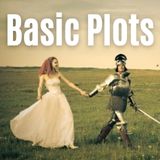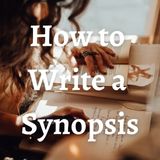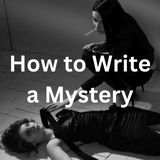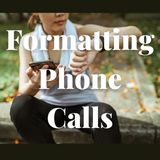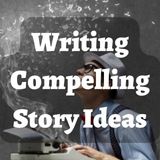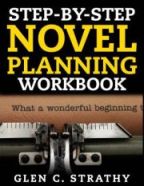Questions about formatting a manuscript
by david fannin
(van lear, ky. United states)
Question: What does it mean to double space your manuscript?
Answer: It means that there is space equal to a blank line between each line of text. Once upon a time, if you were writing on a typewriter, you would hit the carriage return twice at the end of each line rather than once in order to double-space your text. Later typewriters had a setting that allowed you to choose to double or triple space automatically.
Today, any decent wordprocessor will let you adjust the space between lines to double (or 2.0). Look under the format tab/menu for this option or access the help feature.
Question: What does it mean to leave 1 inch to one and a quarter inch margins?
Answer: It means that the words on your page begin 1.25 inches from the left edge of the paper when it's printed, and stops at least 1.25 inches from the right edge of the paper.
The blank area down each side of the paper is called the "margin." This space can be used by an editor (or yourself when editing your own work) to write notes.
Manuscript Spacing
by Marjorie
(Downers Grove, Il, USA)
Question: I am trying to write my first draft manuscript and I wanted to know, regarding manuscript spacing, should I still indent my paragraphs on the manuscript or will that mess up the publisher's word count?
Answer: The standard manuscript format is to indent the first line of each paragraph five spaces to show that it is the start of a new paragraph.
Do not put an extra blank line or any extra partial space between paragraphs or lines. Just stick with standard double-spacing, so that you have 25 lines per page.
(If you want to indicate that a blank line should appear in the printed book, perhaps to show a break in the story or a switch to a new scene, insert a line with just a "#" symbol in the centre. The symbol tells the publisher that there is supposed to be a blank line there, and you didn't accidentally hit the return/enter button by mistake.)
Comments for Manuscript Spacing
|
||
|
||
When and how to use quotation marks and or Italics and reduced font size.
by Nick
(Berkeley, CA)
Question: Here's a potential headache though certainly not a very, very important problem. Advice would be very much appreciated though; I can't find answers in the usual style manuals.
I am writing a novella (18000 words). Pure fiction. Parts of it are extracted from a personal journal of a youth, a (fictitious) diary in principle never meant for publication. In addition, there are three instances in which the youth, in his diary, cites 2 short phrases and a verse of a few lines length by R. Frost, T.S.Eliot and J.Donne.
I imagine I should use devices such as Quotation marks, italics, smaller font size and indentation. Just in which combination, that is my question. Please note this is fiction so I cannot really have (T.S.Eliot) appearing in the story as if this was an academic paper.
My questions:
(1) How do I acknowledge passages extracted from a personal diary, where
(a) a line or less, or
(b) a paragraph or more is involved?
I am quoting from a personal diary, not a work of literature, so how do I do it for (a) and
(b)?
(2) How do I acknowledge material found in the diary which appears to have been lifted from works the writer read, though without specific acknowledgement, where
(a) a line or less, or
(b) a verse of several lines is involved?
(3) How do I acknowledge particular stress on words not from the diary but of my own writing. Quotes? Italics?
How do I do it so there is no confusion between conventions and it becomes clear what is from where in my story.
Many thanks and sorry for this headache, but an experienced writer would surely have the answer. I'd appreciate his/her reply.
Answer: Generally, you keep the same font all the way through a manuscript (Courier 12). Underline anything that should appear in italics. It's an old-fashioned style, but it's clean and easy to read.
Regarding your questions:
1. If you are quoting less than two lines from the diary, just put them in quotation marks, and set them off from the rest of the sentence with commas - the same as you would with a line of dialogue.
If you are quoting more than two lines, make the quotation a separate paragraph and indent each line an extra five spaces. Don't use quotation marks. You may want something to explain what the quotation is from, such as an introductory sentence (ending in a colon) or something like "--John's Diary" at the end.
A quotation within the diary will be treated the same way. It's a quotation nested within a quotation. So, within a long diary passage, you could have a short quote in quotation marks or a long quote that is indented an additional five spaces. If you don't want your character to include the author's name after the quotation, you might have him write something like, "I always liked this poem by T. S. Eliot" or "As John Donne says..."
You do have to be careful about long quotes from authors whose works are still copyrighted (Donne is fine, but Eliot's copyright might still have a year or so left).
Bear in mind that the book designer might choose more fancy ways to treat quotations. In a manuscript, your job is just to make clear your intent.
Exclamation points , and methods to convey emotion in the character's voice
by Christian
(Montreal Quebec Canada)
Hello,
My question is about conveying to the reader a character's changing emotions through his or her voice in a literal sense. How it raises or lowers intensity, how it may break or crack for example as a character gets scared or angry or shocked.
When I write dialogue I try to stay away from exclamation points because it makes me feel like the character is 5 years old, but sometimes I feel like I lack the Tools to convey distress or a feeling of panic or anger in my characters.
Have any ideas?
For reference, my genre would be Fantasy, and it would be more geared towards Young adults.
Thank you for taking the time.
Answer:
Generally, you want to avoid too many exclamation marks, or any other method of conveying emotion through typography. (How much is too much? That's a matter of taste, but definitely not more than one exclamation mark per page.)
You generally have two methods of conveying emotion:
1. When the dialogue is really good, the emotion is obvious to the reader. Admittedly, this takes some skill to write.
2. You can show emotion by describing the action in the narration. A slip of the hand, a crack in the voice, a flush of a cheek, can indicate what emotion the speaker is feeling.
If you want more help with this, a good book on the subject is The Emotion Thesaurus: A Writer's Guide to Character Expression by Angela Ackerman and Becca Puglisi. The book covers 130 emotional states and lists the typical actions, gestures, sensations, and thought processes associated with them.
Comments for Exclamation points , and methods to convey emotion in the character's voice
|
||
|
||
Using Too Many Exclamation Points!!!
by Mike Chiero
(America)
Question: How does one determine that one is using too many exclamation points? Should they be avoided at all costs? Writers are discouraged from dialogue tags such as "Glen screamed" and "Mike shouted" and the like but without using an exclamation point how does a writer get the point across effectively without violating a rule? Thanks, Mr. Strathy!!!
Answer: If you think you're using too many exclamation points, you're using too many exclamation points.
The general guideline in fiction writing is that you want to improve the signal to noise ratio.
The signal is the story. You want to include the words you need to convey the story to the reader the most direct, vivid, and visceral experience possible.
The noise is anything that is redundant or that distracts from the signal. It is anything that is not part of the story.
So, regarding dialogue tags, it is usually better to use simple tags that don't draw attention from the actual words the characters say. This makes it easier for the readers to experience the illusion that they are "hearing" the dialogue as if they were actually present.
Along the same lines, excessive use of punctuation marks is considered a distraction -- more noise.
A reader should be able to deduce the emotion from the character's actual words and actions. Exclamation marks, while they may be helpful on occasion, are often redundant. Frequent use of them can be distracting.
In a similar vein, some writers don't even use quotation marks, believing that if the dialogue is good, it should be obvious what is speech and what is narration.
Of course, it also depends what genre you are writing in. Literary fiction favours authenticity and style above all and tends to shoot for the highest signal to noise ratio.
In genre fiction, aimed for a more general audience, quotation marks, question marks, and occasional exclamation marks are seen as helpful to the readers. Also, a more elaborate speech tag can also be helpful on occasion if it makes the tone of the dialogue clearer.
However, I would not generally use more than one exclamation point per chapter in any genre, other than perhaps children's fiction.
Comments for Using Too Many Exclamation Points!!!
|
||
|
||
|
||
|
||
|
||
|
||
|
||
- Home
- Writing Questions
- Using Too Many Exclamation Points!!!

